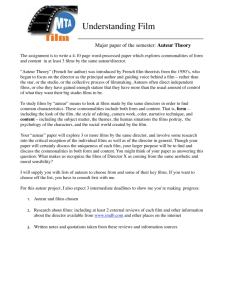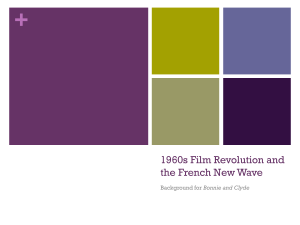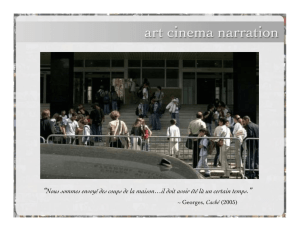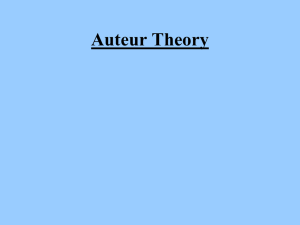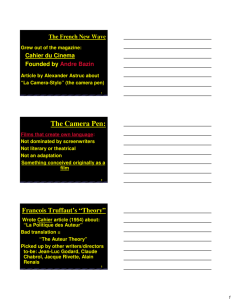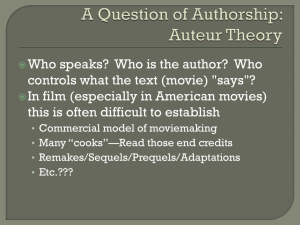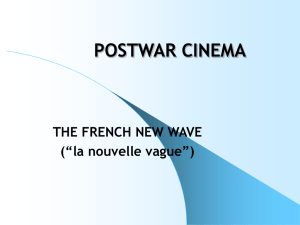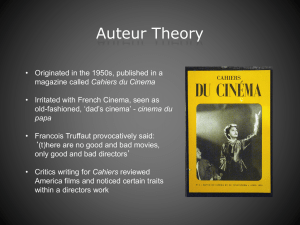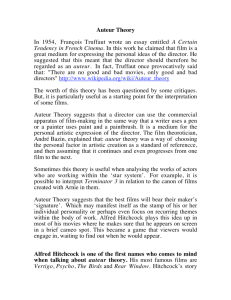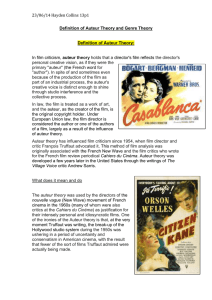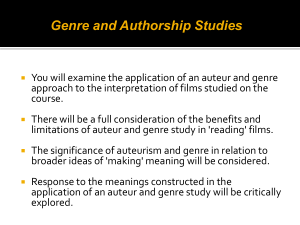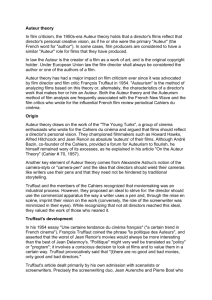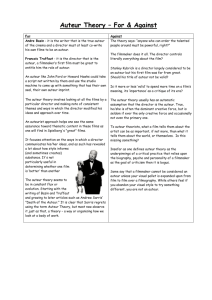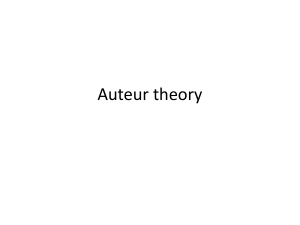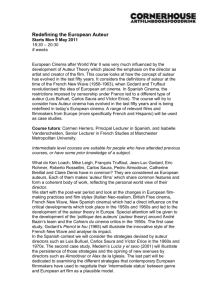The Auteur Theory
advertisement
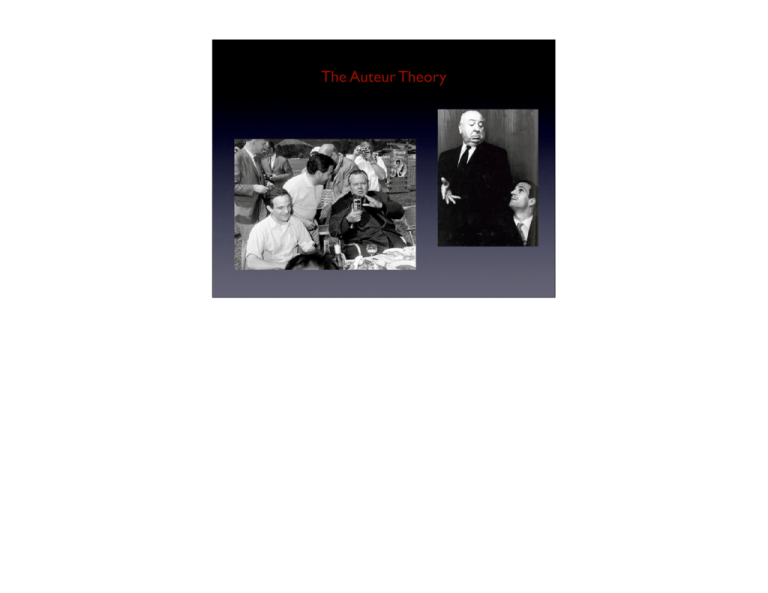
The Auteur Theory The Hollywood Model The Studio System Big Five: • • • Fox • • RKO Paramount Warner Brothers MGM America comes out on top • American and European cinema equally influential until World War II • American films not seen in Europe for the duration of the war • German Occupation prohibited import of American films to France • When ban was lifted, influx of four years worth of movies in 1945 - more than 2000 films to distribute (Compare with 603 American films released in 2007...) American Directors Who Inspired the Auteur Theory Formally ranked as “B” directors • • • • • • Howard Hawks - Bringing Up Baby Alfred Hitchcock - Notorious Fritz Lang - The Big Heat Nicholas Ray - Rebel Without A Cause Orson Welles - Citizen Kane John Ford - The Searchers Alexandre Astruc "The Birth of a New Avant-Garde: The Camera-Stylo” 1948 • Moviemaking was an industrial process... • The director should use the commercial apparatus the way a writer uses a pen (camera-stylo) and, through the mise en scène, imprint their vision on the work. • Challenge the traditional storytelling structure. • Writer becomes less important. Andre Bazin • Films should reflect a director's personal vision • Beginning of auteur theory provided a way to organize film criticism and to rebel against the French filmmaking establishment - “Papa’s cinema” • Founded Cahiers du Cinema 1951 “The Tradition of Quality emphasized craft over innovation, privileged established directors over new directors, and preferred the great works of the past to experimentation. Literary adaptation provided fertile ground for this decade, on the part of those who were anxious to prove the cultural superiority of French film in the face of a massive influx of Hollywood movies into the French market.” “A Certain Tendency of the French Cinema” Francois Truffaut "Une Certaine tendance du cinéma française" (1954) • The French weekly news magazine L'Express called Truffaut ... "a hateful enfant terrible who puts his foot in his mouth with unbearable self-conceit" The 400 Blows 1959 • The Nouvelle Vague - (New Wave) - was born Francois Truffaut - 400 Blows Jean-Luc Godard - Breathless Claude Chabrol - Le Beau Serge Jacques Rivette Céline and Julie Go Boating Alain Renais - Last Year at Marienbad Eric Roehmer - Claire’s Knee A story should have a beginning, a middle, and an end . . . but not necessarily in that order. Jean-Luc Godard Tenets of New Wave style • Jump cuts: a non-naturalistic edit, usually a section of a continuous shot that is removed unexpectedly, illogically • • • Shooting on location Natural lighting Improvised dialogue and plotting • • Direct sound recording Long takes American New Wave • • 1950s - Death of studio system due to television 1960s-70s - Coppola, Scorsese, Spielberg, Altman, Lucas Andrew Sarris • The American Cinema: Directors and Directions 1929-1968 • Popularized the Auteur Theory in America The Sarris Pantheon 1. Robert Flaherty 2. John Ford 3. D. W. Griffith 4. Howard Hawks 5. Buster Keaton 6. Orson Welles 7. Fritz Lang 8. Ernst Lubitsch 9. F. W. Murnau 10.Max Ophuls 11.Josef von Sternberg 12.Charles Chaplin 13.Alfred Hitchcock 14.Jean Renoir Premises of Auteur Theory • Technical competence of director as a criterion of value • Distinguishable personality of the director as a criterion of value • “The third and ultimate premise of the auteur theory is concerned with interior meaning, the ultimate glory of the cinema as an art. Interior meaning is extrapolated from the tension between a director’s personality and his material”. Pauline Kael “Circles and Squares” • Many good films made by technically inept directors. • “The smell of a skunk is more distinguishable than the perfume of a rose; does that make it better?” • Artist expresses himself in the unity of form and content, not the tension. Pros of perpetuating of the auteur theory • Easy to market films branding • A way to organize criticism of films • Includes commercial films Cons of perpetuating the auteur theory • Cult of personality - Too much director power • Misses opportunity to appreciate the most collaborative of the arts • Excludes analysis of the influences of the collaborators on the final film • Elevates bad films and ignores good ones if they don’t fit that director’s paradigm Things to Think About... • “Interior meaning is extrapolated from the tension between a director’s personality and his material”. Tension is actually between director, circumstance, crew, producer... • New idea of authorship in general - recent availability of technology means true auteurism http://www.youtube.com/blog?entry=4KWKYZN7znU A gathering in Los Angeles, 1972: (from left to right standing) Robert Mulligan, William Wyler, George Cukor, Robert Wise, Jean-Claude Carrière, Serge Silberman; (seated) Billy Wilder, George Stevens, Buñuel, Alfred Hitchcock, Rouben Mamoulian. “Making of” videos have demystified filmmaking process Judge the Art, not the Artist “Tremors” Ron Underwood “Nightmare on Elm Street” Wes Craven Coppola’s Process Who has more power the director or the producer? Producer’s role is redefined each time by the nature of the… • Project - indie, studio project, sequel… • Director’s style and personality • • Cast - big stars Funding - Independent financiers, bond company • Relationship with director and cast • Thankless job • “The buck stops here” for problems Works Cited • • Balio, Tino. The American Film Industry. Madison: University of Wisconsin Press, 1976. • Gerstner, David A., and Janet Staiger. Authorship and Film : Trafficking with Hollywood. New York: Routledge, 2003. • Kael, Pauline. "Circles and Squares." Film Quarterly 16.3 (1963): 12-26. <http:// www.jstor.org/stable/1210726>. • Macklin, F. Anthony, and Nick Pici.Voices from the Set : The Film Heritage Interviews. Lanham, Md.: Scarecrow Press, 2000. • Marie, Michel, and Richard John Neupert. The French New Wave : An Artistic School. Malden, MA: Blackwell Pub., 2003. • Monaco, James. The New Wave : Truffaut, Godard, Chabrol, Rohmer, Rivette. New York: Oxford University Press, 1976. Braddock, Jeremy, Stephen Hock, and Andrew Sarris. Directed by Allen Smithee. Minneapolis: University of Minnesota Press, 2001. • Prince, Stephen. Movies and Meaning : An Introduction to Film. Boston: Allyn and Bacon, 1997. • Sarris, Andrew. The American Cinema : Directors and Directions, 1929-1968. New York: E. P. Dutton & Co, 1968. • Schatz, Thomas. The Genius of the System : Hollywood Filmmaking in the Studio Era. 1st ed. New York: Pantheon, 1988. • Trumpbour, John. Selling Hollywood to the World : U.S. and European Struggles for Mastery of the Global Film Industry, 1920-1950. Cambridge, U.K. ; New York: Cambridge University Press, 2002. • Vest, James M. "The Making of Downhill and its Impact on Hitchcock's Reputation." , 2005. 50-94. <http://search.ebscohost.com/login.aspx? direct=true&db=fah&AN=23598608&site=ehost-live>. • WILLIAM GRIMES. "The Auteur Theory of Film: Holy Or just Full of Holes?" New York Times (1993): 9. <http://search.ebscohost.com/login.aspx? direct=true&db=aph&AN=30202345&site=ehost-live>.

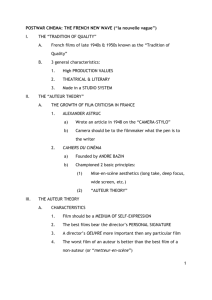
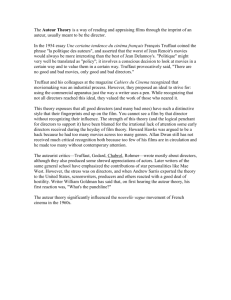
![[Lecture 17] Kiarostami for wiki 2012](http://s2.studylib.net/store/data/010226044_1-2bd9bf3346eddb7edb648289f56bc956-300x300.png)

